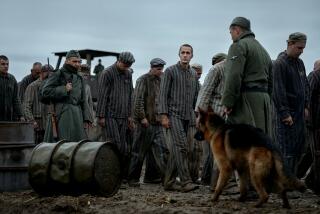The Civil War’s turbulent aftermath
- Share via
It was supposed to be a time of healing, of binding the nation’s wounds. Yet Reconstruction, the period following four years of Civil War, proved a punishing passage from slavery to freedom.
A noteworthy presentation of the “American Experience: Reconstruction: The Second Civil War,” powerfully and poetically explores this difficult journey. PBS’ deconstruction of Reconstruction thoughtfully recounts America’s efforts to amend the past. Indeed, what resulted from government fiat triggered incendiary emotions that sometimes ended in bloodshed. Through archival pictures and reenactments (the latter often heavy-handed considering “Reconstruction’s” otherwise sensitive touch), an enduring sense of a controversial era emerges. As decisively drawn by this two-night broadcast, we come to see Reconstruction as a time defined by harrowing uncertainties. Perhaps the central unifying theme is “contradiction”; the nation locked on a course of antagonism and occasionally enlightenment.
In fact, just three days after Abraham Lincoln delivered a speech in which he spoke of future days “fraught with great difficulty,” he was assassinated. After Lincoln’s death, the presidency was filled by Andrew Johnson, who emerged as a headstrong reactionary at odds with radical Republicans pushing to give blacks the vote. He prolonged slavery’s wrongs by vetoing the Freedman’s Bureau and opposing the 14th Amendment, legislation that, in effect, granted African Americans citizenship.
Not that political skulduggery was the monopoly of one party during Reconstruction. Democrats ran a decidedly racist campaign against Republican Ulysses S. Grant during his successful presidential run in 1868. In pushing the candidacy of Democratic standard-bearer Horatio Seymour, Democratic campaign handbills proclaimed: “This is a white man’s country. Let white men rule it.”
“Reconstruction” commences with a program titled “Revolution.” This installment begins at the Civil War’s end and proceeds to examine federal attempts to impose order on a divided nation. On night 2, “Retreat” recounts the push-pull responses to Reconstruction, and how the challenge of moving forward was nearly a greater testing than winning the war.
Through it all we meet a varied and vigorous clutch of activists. We come to know John Roy Lynch, once a slave from Mississippi who went on to serve in Congress and press for freedom when it most mattered. We are introduced to Kate Stone, a Southern woman to the manor born whose privileged life ends with Gen. Lee’s surrender at Appomattox in April 1865. We are also privy to the times of Marshall Twitchell, a rough and tumble Yankee vet from New England who led black soldiers into battle and was later dispatched to establish order in a hardscrabble stretch of Louisiana.
“Reconstruction” renders a compelling appraisal of America’s political, spiritual and social battles from Civil War’s end to 1877. This is the year Reconstruction died, killed by backroom politics brokered by Republicans and Democrats. Although the shooting was over, the deep underlying animosities remained. Indeed, the broadcast convincingly reanimates the clashing ideologies and antagonistic goals pushed by competing factions after Lee’s surrender.
History as transmitted by television is all too often delivered through a glass darkly, the TV lens distorting events. But “Reconstruction: The Second Civil War” arrives with undimmed force. Producers-directors Llewellyn M. Smith and Elizabeth Deane give us a visceral sense of a dysfunctional nation trying to find its equilibrium. And to this end, the broadcast puts its subject in focus, presenting crisscrossing currents of racial politics and regional aspirations that afflict us still.
*
‘Reconstruction: The Second Civil War’
Where: KCET
When: 9-10:30 p.m. today and Tuesday
Rating: The network has rated the documentary TV-PG (may not be suitable for young children).
Narrator...Dion Graham
Producers and directors: Llewellyn M. Smith and Elizabeth Deane.
More to Read
The complete guide to home viewing
Get Screen Gab for everything about the TV shows and streaming movies everyone’s talking about.
You may occasionally receive promotional content from the Los Angeles Times.






